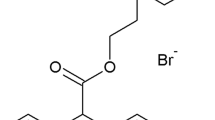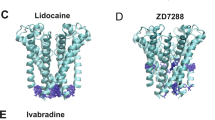Abstract
We have recently reported that class III antiarrhythmic drugs inhibit the muscarinic acetylcholine (ACh) receptor-operated K+ current (I K, ACh) in guinea-pig atrial cells by different molecular mechanisms. The data obtained from the patch-clamp study suggest that d,l-sotalol inhibits I K, ACh by blocking the muscarinic receptors, whereas MS-551 inhibits the K+ current by blocking the muscarinic receptors and depressing the function of the K+ channel itself and/or the guanine nucleotide-binding protein (G protein). This study was undertaken to determine whether the class III antiarrhythmic drugs d,l-sotalol and MS-551 interact with the muscarinic receptors of cardiac and peripheral tissues. Both drugs inhibited concentration dependently the specific [3H]N-methylscopolamine ([3H]-NMS) binding to membrane preparations obtained from guinea-pig atria and submandibular glands. The competition curves of these drugs for [3H]-NMS binding to glandular membranes were monophasic, suggesting competition with [3H]-NMS at a single site. Although the competition curve of d,l-sotalol for [3H]-NMS binding to atrial membranes was monophasic, that of MS-551 was biphasic and showed high- and low-affinity states of binding. d,l-Sotalol showed slightly, but significantly, higher affinity for cardiac-type muscarinic receptors (M2) than for glandular-type muscarinic receptors (M3). The inhibition constant (K i) for MS-551 in glandular membranes was also slightly greater than the high-affinity K i value for the drug in atrial membranes. In guinea-pig left atria and ilea, d,l-sotalol shifted the concentration-response curves for the negative inotropic effect and the contracting effect of carbachol in a parallel manner. The slopes of Schild plot were not significantly different from unity, suggesting competitive antagonism, and the pA2 for d,l-sotalol in left atria was slightly greater than that in ilea. MS-551 also shifted the concentration response curve for the negative inotropic effect of carbachol in atrial preparations to a greater extent than that for the contracting effect in ileal preparations, although MS-551 failed to show a pure competitive antagonism. These results suggest that both d,l-sotalol and MS-551 interact with cardiac M2 and peripheral M3 receptors, and that at high concentrations they exert anticholinergic activity in cardiac and peripheral tissues.
Similar content being viewed by others
References
Arunlakshana O, Schild HO (1959) Some quantitative uses of drug antagonists. Br J Pharmacol 14:48–58
Bigger JT, Hoffman BF (1990) Antiarrhythmic drugs. In: Gilman AG, Rall TW, Nies AS, Taylor P (eds) The pharmacological basis of therapeutics, 8th edn. Pergamon Press, New York, pp 840–873
Bonner TI (1989) The molecular basis of muscarinic receptor diversity. Trends Neurol Sci 12:148–151
Brown BW Jr, Hollander M (1977) Statistics: A biomedical introduction. John Wiley, New York, pp 261–307
Carmeliet E (1994) Action potential duration and refractoriness. In: Singh BN, Wellens HJJ, Hiraoka M (eds) Electropharmacological control of cardiac arrhythmias: to delay conduction or to prolong refractoriness? Futura, Mt Kisco, New York, pp 33–46
Cheng YC, Prusoff WH (1973) Relationship between the inhibition constant (K i) and the concentration of inhibitor which causes 50 per cent inhibition (IC50) of an enzymatic reaction. Biochem Pharmacol 22:3099–3108
Coumel P, Leclercq JF; Attuel P, Lavellée JP, Flammang D (1979) Autonomic influences in the genesis of atrial arrhythmias: Atrial flutter and fibrillation of vagal origin. In: Narula DS (ed) Cardiac arrhythmias: electrophysiology, diagnosis and management. Williams and Wilkins, Baltimore, pp 243–255
Doods HN, Mathy M-J, Davidesko D, Charldorp KJ van, Jonge A de, Zwieten PA van (1987) Selectivity of muscarinic antagonists in radioligand and in vivo experiments for the putative M1, M2 and M3 receptors. J Pharmacol Exp Ther 242:257–262
Endou M, Gando S, Hattori Y, Kanno M (1991) Binding profiles of class I antiarrhythmic agents to cardiac muscarinic receptors: competitive and allosteric interactions with the receptors and their pharmacological significance. J Pharmacol Exp Ther 258:992–998
Endou M, Hattori Y, Gando S, Kanno M (1992) Selectivity of class I antiarrhytmic agents, disopyramide, pirmenol, and pentisomide for peripheral muscarinic M2 and M3 receptors. J Cardiovasc Pharmacol 19:674–681
Feld GK, Venkatesh N, Singh BN (1986) Pharmacologic conversion and suppression of experimental canine atrial flutter: differing effects of d-sotalol, quinidine, and lidocaine and significance of changes in refractoriness and conduction. Circulation 74:197–204
Giraldo E, Viganó MA, Hammer R, Ladinsky H (1988) Characterization of muscarinic receptors in guinea pig ileum longitudinal smooth muscle. Mol Pharmacol 33:617–625
Inomata N, Ohno T, Ishihara T, Akaike N (1993) Antiarrhythmic agents act differently on the activation phase of the ACh response in guinea-pig atrial myocytes. Br J Pharmacol 108:111–115
Juul-Möller S, Edvardsson N, Rehnqvist-Ahlberg N (1990) Sotalol versus quinidine for the maintenance of sinus rhythm after direct current conversion of atrial fibrillation. Circulation 82:1932–1939
Lazareno S, Roberts FF (1989) Functional and binding studies with muscarinic M2-subtype selective antagonists. Br J Pharmacol 98:309–317
Le Coz F, Funck-Brentano C, Poirier J-M, Kibleur Y, Mazoit FX, Jaillon P (1992) Prediction of sotalol-induced maximum steady state QTc prolongation from single-dose administration in healthy volunteers. Clin Pharmacol Ther 52:417–426
Lowry OH, Rosebrough NJ, Farr AL, Randall RJ (1951) Protein measurement with the Folin phenol reagent. J Biol Chem 193:265–275
Mirro MJ, Manalan AS, Bailey JC, Watanabe AM (1980) Anticholinergic effects of disopyramide and quinidine on guinea pig myocardium: Mediation by direct muscarinic receptor blockade. Circ Res 47:855–865
Monferini E, Girado E, Ladinsky H (1988) Characterization of the muscarinic receptor subtypes in the rat urinary bladder. Eur J Pharmacol 147:453–458
Mori K, Hara Y, Saito T, Masuda Y, Nakaya H (1995) Anticholinergic effects of class III antiarrhythmic drugs in guinea pig atrial cells: different molecular mechanisms. Circulation 91:2834–2843
Munson PJ, Rodbard D (1980) Ligand: A versatile computerized approach for characterization of ligand-binding systems. Anal Biochem 107:220–239
Nakajima T, Kurachi Y, Ito H, Takikawa R, Sugimoto T (1989) Anticholinergic effects of quinidine, disopyramide, and procainamide in isolated atrial myocytes: mediation by different molecular mechanisms. Circ Res 64:297–303
Nakaya H, Hattori Y, Endou M, Gandou S, Kanno M (1992) Electrophysiologic and anticholinergic effects of pirmenol enantiomers in guinea-pig myocardium. Naunyn-Schmiedeberg's Arch Pharmacol 346:555–562
Nakaya H, Tohse N, Takeda Y, Kanno M (1993) Effects of MS-551, a new class III antiarrhythmic drug, on action potential and membrane currents in rabbit ventricular myocytes. Br J Pharmacol 109:157–163
Poirier JM, Jaillon P, Lecocq V, Ferry A, Cheymol G (1990) The pharmacokinetics of d-sotalol and d,l-sotalol in healthy volunteers. Eur J Clin Pharmacol 38:579–582
Roffel AF, Meurs H, Elzinga CRS, Zaagsma J (1990) Characterization of the muscarinic receptor subtype involved in phosphoinositide metabolism in bovine tracheal smooth muscle. Br J Pharmacol 99:293–296
Scatchard G (1949) The attraction of proteins for small molecules and ions. Ann NY Acad Sci 51:600–672
Singh BN, Ahmed R, Sen L (1993) Prolonging cardiac repolarization as an evolving antiarrhythmic principle. In: Escande D, Standen N (eds) K+ channels in cardiovascular medicine. Springer, Berlin Heidelberg New York, pp 247–272
Spinelli W, Hoffman BF (1989) Mechanisms of termination of reentrant atrial arrhythmias by class I and class III antiarrhythmic agents. Circ Res 65:1565–1579
Strauss HC, Bigger JT Jr, Hoffman BF (1970) Electrophysiological and beta-receptor blocking effects of MJ 1999 on dog and rabbit cardiac tissue. Circ Res 26:661–678
Uprichard ACG, Lucchesi BR (1994) The efficacy of antiarrhythmic drugs as antifibrillatory agents. In: Singh BN, Wellens HJJ, Hiraoka M (eds) Electropharmacological control of cardiac arrhythmias: to delay conduction or to prolong refractoriness? Futura, Mt Kisco, New York, pp 291–312
Waelbroeck M (1994) Identification of drugs competing with d-tubocurarine for in allosteric site on cardiac muscarinic receptors. Mol Pharmacol 46:685–692
Waelbroeck M, Neef P de, Robberecht P, Christophe J (1984) Inhibitory effects of quinidine on rat heart muscarinic receptors. Life Sci 35:1069–1076
Wang T, Bergstrand RH, Thompson KA, Siddoway LA, Duff HJ, Woosley RR, Roden DM (1986) Concentration-dependent pharmacologic properties of sotalol. Am J Cardiol 57:1160–1165
Wu SN, Nakajima T, Yamashita T, Hamada E, Hazama H, Iwasawa K, Omata M, Kurachi Y (1994) Molecular mechanism of cibenzoline-induced anticholinergic action in single atrial myocytes: comparison with effect of disopyramide. J Cardiovasc Pharmacol 23:618–623
Author information
Authors and Affiliations
Rights and permissions
About this article
Cite this article
Uemura, H., Hara, Y., Endou, M. et al. Interaction of class III antiarrhythmic drugs with muscarinic M2 and M3 receptors: radioligand binding and functional studies. Naunyn-Schmiedeberg's Arch Pharmacol 353, 73–79 (1995). https://doi.org/10.1007/BF00168918
Received:
Accepted:
Issue Date:
DOI: https://doi.org/10.1007/BF00168918




